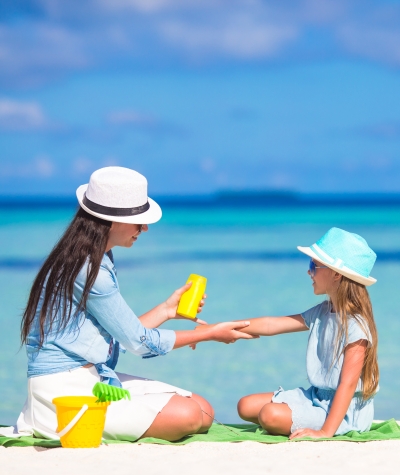The sections of this page are:
- How can I be sure sunscreen is safe to use?
- How can I trust the SPF of the sunscreen?
- How sunscreens are developed infographic
- How long can I keep my sunscreen?
Sprays, creams or oils which are light, non-greasy, easy to spread and invisible on the skin mean you can choose a sunscreen that best meets your needs.
Sunscreens are one of the most studied and tested of all cosmetic products and there is a legal requirement that all cosmetics in the UK and Europe must undergo a very strict safety assessment by a qualified safety assessor. The assessment covers the safety of the finished product as well as all of the individual ingredients, how and where the product is to be used, by whom and how often.
How can I be sure sunscreen is safe to use?
Safety is the number one priority of the cosmetics industry. ALL cosmetic products, including sunscreens, placed on the market in the UK are regulated by strict UK laws to protect those who use cosmetics.
There are three layers to the safety assurance process:
-
UK legislation requires cosmetics to be safe.
-
The professional Safety Assessor personally signs-off to say the cosmetic product is safe.
-
Products placed on the market are monitored; any adverse reactions are addressed by companies and may have to be reported to the authorities.
Because of this rigorous process, we can be absolutely confident that the sunscreen we buy is safe to use and will do what it says it does.
How can I trust the SPF of the sunscreen?
As well as ensuring safety, the cosmetics laws also require that any claim made by a product must be substantiated (and an SPF number and UVA protection are claims). To make a claim requires robust evidence.
Our knowledge of the sun and its harmful effects on the skin has improved over many years. Today's sunscreens have been developed to help protect the skin against the damaging rays of the sun as part of a sun safe regime. People can be confident in using sunscreens because they have been developed and tested by scientists with expert suncare knowledge.
Everyone reacts to the sun in their own way. Some people's skin is affected more by the sun's harmful rays than others. The SPF of a sunscreen it is measured by testing it in a standard way on a range of people to take this into account. This international standardised test provides an SPF number.
In the test, the set amount of product is applied to a measured area of skin on a number of people who are exposed to a specific amount of sunlight. The reaction of their skin is then assessed. But cosmetics companies don't just rely on just one test for the SPF number. During development, the product is tested by scientists a number of times to check the SPF is on track.
By the time the product has reached the point of the final SPF test on human volunteers, it has already been tested by scientists a number of times to ensure consistent results are seen.
This robust development and testing process is what companies go through before they label their product and put it on the shelf. So we can be confident the level of protection on the pack is correct.
A separate test is performed to ensure the UVA protection has been achieved.
Dr Anjali Mahto, Consultant Dermatologist and British Skin Foundation Spokesperson, explains how much sunscreen we should be using and how often to reapply!
Dr Emma Meredith, Director-General of CTPA, explains why we can rely on all sunscreens, regardless of brand or price:
Dr Chris Flower, Former Director-General of CTPA, explains how sunscreens are developed and how SPF is tested.
How long can I keep my sunscreen?
Cosmetic legislation requires that if a product has a limited shelf life (less than 30 months) then it must have a "best before" date on the pack. "Best before" dating is not common as most cosmetic products are formulated to ensure they have a long shelf life. Even so, some consumers want to know how long an opened product can be kept. For products with a shelf life of at least 30 months, products may be labelled with the "period after opening" (PAO ). The period is given as a number of months and is marked with a letter "M" under or within the 'open jar' symbol and it gives an indication of how long the product remains useable after opening.
In practice, most cosmetic and personal care products are formulated to ensure they have a shelf-life and PAO time which far exceeds the normal time it would take to use the product up. This is certainly the case for sunscreens, provided they are stored under suitable conditions and not subjected to extreme temperatures.
Sunscreens should be stored in a cool, dry place, away from direct sunlight and with the lids firmly closed. Sunscreens should not be exposed to repeated extreme changes in temperature, such as from refrigerator to car parcel shelf.
Products used extensively on a beach or left open for a length of time should generally be discarded after the holiday period. With correct storage and handling, nearly full packs may be kept until the following season, but small amounts left in the bottom of containers should be discarded. Also, a visual check will show if the product has separated or become contaminated. Discard a product if it has become discoloured, has an unpleasant odour or doesn't look like it should.


